Exploring Thunderbolt 3 eGFX Performance, Feat. PowerColor's Gaming Station & Radeon RX Vega 56 Nano
by Ganesh T S on February 13, 2019 10:00 AM EST- Posted in
- GPUs
- AMD
- Radeon
- PowerColor
- Thunderbolt 3
- eGFX
- RX Vega 56 Nano Edition
Workstation Workloads - SPECviewperf 13
The SPECviewperf benchmark from SPEC provides an idea of the capabilities of the GPU in a workstation from the perspective of different CAD, content creation, and visual data analysis tools. It makes more sense to process these benchmarks on workstations with professional GPUs, but, consumer GPUs are often the choice for machines that need to handle both gaming and professional workloads.
SPECviewperf 13 includes nine different workloads representative of graphics content and behavior of actual applications. They make use of the OpenGL 4.0 and DirectX 12 APIs under Windows. SPECviewperf 13's workloads (termed viewsets) can officially be run only at two desktop resolutions (1920 x 1080, and 3840 x 2160), and need the dsplay scaling to be set to 100% (DPI of 96). The available viewsets are listed below.
- 3ds Max (3dsmax-06)
- CATIA (catia-05)
- Creo (creo-02)
- Energy (energy-02)
- Maya (maya-05)
- Medical (medical-02)
- Showcase (showcase-02)
- Siemens NX (snx-03)
- Solidworks (sw-04)
The 3ds Max and Showcase viewsets are available only when processing at 1920 x 1080. The rest are available at both resolutions.
We processed SPECviewperf 13 at both resolutions on all the systems. The benchmark measures the frame rate at which the GPU renders the scenes in a viewset. Each viewset is composed of different scenes and rendering modes, and the composite score for the viewset is a weighted geometric mean of the FPS measured for the different scenes. In this section, we take a look at how its composite scores stack up against other systems targeting this market segment.
3ds Max (3dsmax-06)
The 3dsmax-06 viewset comprises of 11 different scenes. They have been created from traces of the graphics workload generated by Autodesk 3ds Max 2016 using the default Nitrous DX11 driver. Additional details are available here.
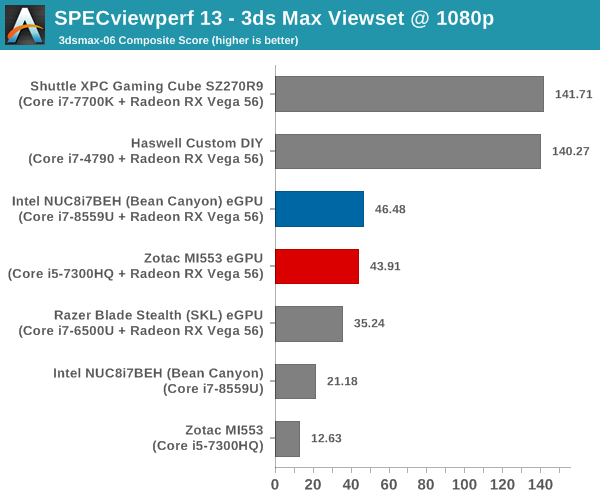
The host - GPU bandwidth seems to have a significant impact in this workload, as the x16 configuration outperforms the x4 eGPU performance by more than a factor of 3.
CATIA (catia-05)
The catia-05 viewset comprises of 14 different tests created from traces of the graphics workload generated by the CATIA V6 R2012 application from Dassault Systemes. Additional details are available here.
| SPECviewperf 13: CATIA Viewset Composite Scores | |||
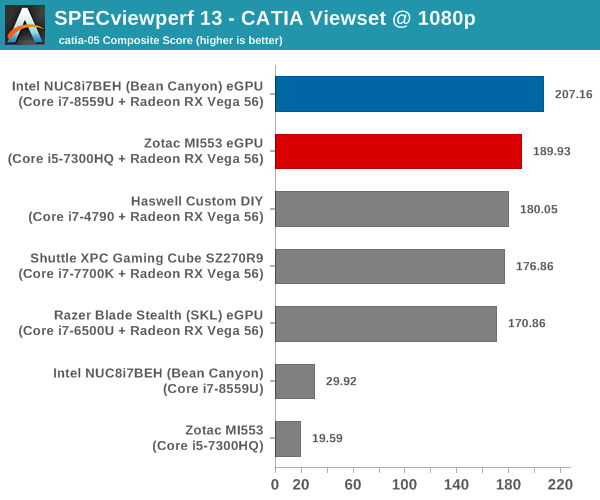
Unlike 3ds Max, CATIA doesn't seem to be influenced by the host - GPU bandwidth. The CPU power in terms of burst frequencies and number of threads appear to have more of an impact.
Creo (creo-02)
The creo-02 viewset comprises of 16 different tests created from traces of the graphics workload generated by the Creo 3 and Creo 4 applications from PTC. Additional details are available here.
| SPECviewperf 13: Creo Viewset Composite Scores | |||
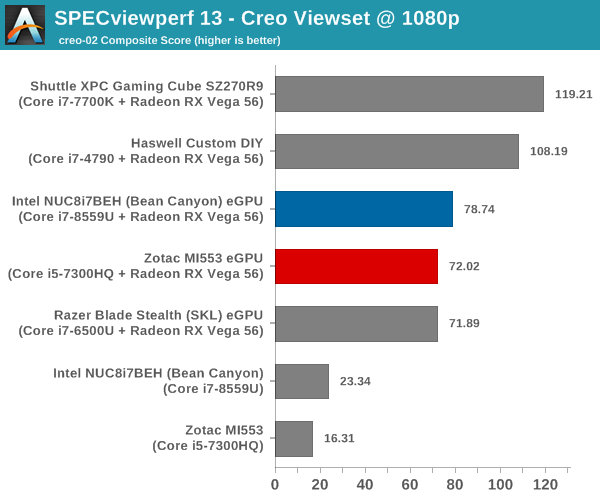
Creo shows sensitivity to the host - GPU bandwidth, just like 3ds Max.
Energy (energy-02)
The energy-02 viewset comprises of 6 different tests based on techniques used by the OpendTect seismic visualization application. Additional details are available here.
| SPECviewperf 13: Energy Viewset Composite Scores | |||

The energy viewset doesn't show much of a performance difference across the different systems, showing that the workload is likely fully limited by GPU capabilities.
Maya (maya-05)
The maya-05 viewset comprises of 10 different tests based on traces of the graphics workload generated by Autodesk Maya 2017. Additional details are available here.
| SPECviewperf 13: Maya Viewset Composite Scores | |||

Like 3ds Max, Maya is sensitive to the host - GPU bandwidth, but, we don't see as much of a difference in the relative numbers with this workload.
Medical (medical-02)
The medical-02 viewset comprises of 8 different tests derived from 4 distinct datasets. Each test uses the ImageVis3D volume visualization program's Tuvok rendering core for 2D projections of 3D volumetric grids. Additional details are available here.
| SPECviewperf 13: Medical Viewset Composite Scores | |||
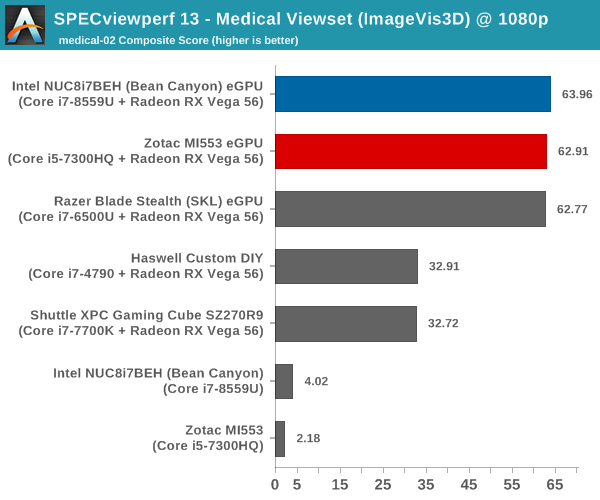
For some unexplained reason, the medical viewset seems to perform better with the eGPU configurations.
Showcase (showcase-02)
The showcase-02 viewset comprises of 4 tests created from traces of the Autodesk Showcase 2013 application rendering a racecar model with 8 million vertices using different modes. Additional details are available here.
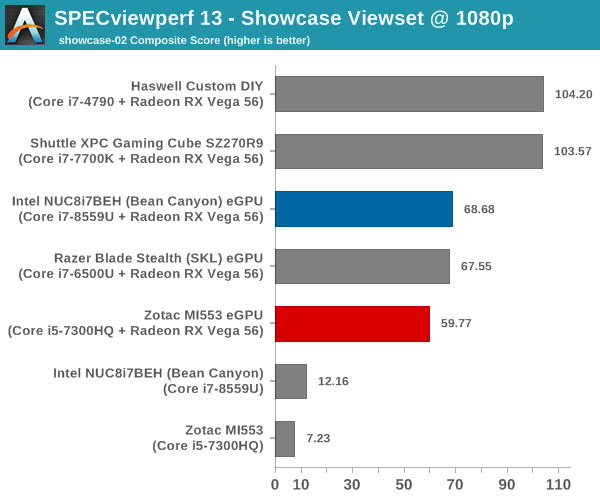
This workload is again sensitive to the host - GPU bandwidth - not as much as 3ds Max, but, more than Maya.
Siemens NX (snx-03)
The snx-03 viewset comprises of 10 tests created with traces from the graphics workload generated by the NX 8.0 application from Siemens PLM. Additional details are available here.
| SPECviewperf 13: Siemens NX Viewset Composite Scores | |||

snx-03 shows almost a 5x performance difference in favor of the internal GPU solutions.
Solidworks (sw-04)
The sw-04 viewset comprises of 11 tests created from traces of Dassault Systemes’ SolidWorks 2013 SP1 application. Additional details are available here.
| SPECviewperf 13: Solidworks Viewset Composite Scores | |||

Solidworks appears to be CPU-limited, with the Bean Canyon eGPU solution performing almost as well as the two internal GPU solutions.










25 Comments
View All Comments
Sunday Afternoon - Wednesday, February 13, 2019 - link
This is a version of the Mantiz Venus by another name. Here's a quiet mod that I did: https://egpu.io/forums/builds/2017-2018-15-macbook...sorten - Thursday, February 14, 2019 - link
Thanks Ganesh, great review. I've been very curious about the importance of the host system's TDP because of my interest in attaching a Surface Pro to an eGPU (in the perfect future where Microsoft finally caves on USB-C and TB). Looks like some games and benchmarks definitely need some CPU help, but a 30% average hit compared to a desktop with an internal GPU is not bad!eastcoast_pete - Thursday, February 14, 2019 - link
The fact that the Vega 56 throttled to avoid over heating shows one of the shortcomings of this box - not enough ventilation. A pair of larger vents/fans is definitely in order, especially if the manufacturer seems to think the enclosure should be okay with higher-end cards. Having only an 80 mm and a 40 mm fan won't do, unless you game in a meatlocker, and that gets old fast.PeachNCream - Thursday, February 14, 2019 - link
The GPU performance might be a problem inherent to the card rather than the enclosure. We are talking about a small form factor Vega 56 so it would be interesting to get the same thermal analysis with that specific card inside a desktop case.BuddyRich - Friday, February 15, 2019 - link
It would be interesting to test this eGPU with the new mac mini as it was designed with an eGPU in mind and has a desktop CPU in it - even dual booting into Windows.